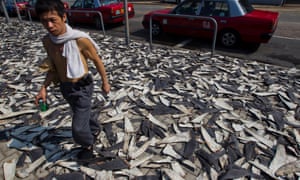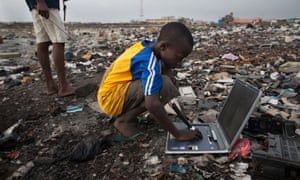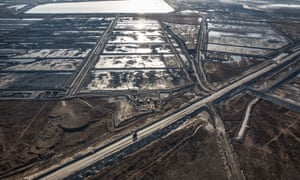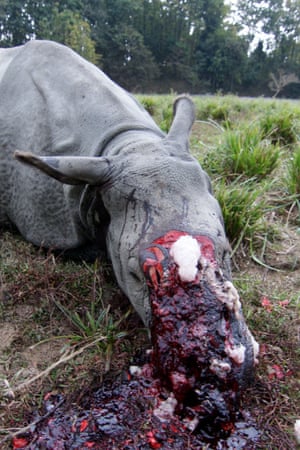Scientists have been warning for decades that human actions are pushing life on our shared planet toward mass extinction. Such extinction events have occurred five times in the past, but a bold new paper finds that this time would be fundamentally different. Fortunately, there’s still time to stop it.
Periodically, in the vast spans of time that have preceded us, our planet’s living beings have been purged by planetary catastrophes so extreme they make your typical Ice Age look like the geological equivalent of a stroll in the park. Scientists count just five mass extinctions in an unimaginably long expanse of 450 million years, but they warn we may well be entering a sixth.
According to a bold new paper in The Anthropocene Review, this time would be different from past mass extinctions in four crucial ways – and all of these stem from the impact of a single species that arrived on the scene just 200,000 years ago: Homo sapiens.
“There is no point in apportioning blame for what is happening,” said lead author and geologist, Mark Williams, with the University of Leicester, since humans “didn’t deliberately engineer this situation.”
“Rather we have to recognise that our impact is game-changing on this planet, that we are all responsible, and that we have to become stewards of nature – as a part of it, rather than behaving like children rampaging through a sweetshop,” Williams noted.
 |
| Some scientists argue that amphibians are already experiencing a mass extinction. The golden toad has not been seen since 1989 and is believed extinct, possibly due to a combination of habitat loss and the chytrid fungus which has wiped out amphibians around the world. It’s belived the chytrid fungus was delivered via internaitonal travelers. Photograph: Conservation International/PA |
The impacts of a still-avoidable sixth mass extinction would likely be so massive they’d be best described as science fiction. It would be catastrophic, widespread and, of course, irreversible. In the past, it has taken life ten to thirty million years to recover after such an extinction, 40 to 120 times as long as modern-looking humans have been telling tales by firelight. Moreover, Williams and his team argue that future changes driven by humanity may go so far as to create not just a new epoch in geologic history – such as the widely-touted Anthropocene – but a fundamental reshaping of Earth on par with the rise of microbes or the later shift from microbes to multicellular organisms.
“Fundamental changes on a planetary system scale have already begun,” said co-author Peter Haff, a geologist and engineer with Duke University. “The very considerable uncertainty is how long these will last – whether they will simply be a brief, unique excursion in Earth history, or whether they will persist and evolve into a new, geologically long-lasting, planetary state.”
But what are these “fundamental changes” that would makes this mass extinction different from the previous five?
“Episodes of global warming, ocean acidification and mass extinction have all happened before, well before humans arrived on the planet,” co-author Jan Zaleasiewicz, a paleobiologist with the University of Leicester, said. “We wanted to see if there was something different about what is happening now.”
Turns out there is.
Meet the four horsemen of the Sixth Mass Extinction
 |
| A firefighter holds a water pipe as they extinguish a fire on burned peatlands in Palembang, South Sumatra, Indonesia. The air pollution or haze has been an annual problem for the past 18 years in Indonesia. It’s caused by the illegal burning of forest and peat fires on the islands of Sumatra and Borneo to clear new land for the production of pulp, paper and palm oil. Singapore and Malaysia have offered to help the Indonesian government to fight against the fires, as infants and their mothers are evacuated to escape the record pollution levels. Photograph: Ulet Ifansasti/Getty Images |
The team of geologists and biologists say that our current extinction crisis is unique in Earth’s history due to four characteristics: the spread of non-native species around the world; a single species (us) taking over a significant percentage of the world’s primary production; human actions increasingly directing evolution; and the rise of something called the technosphere.
The first real change is what the authors of the study call the “global homogenisation of flora and fauna.” Basically what this means is that you can eat tomatoes in Italy, hunt oryx in Texas, ride horses in Chile, curse cane toads in Australia, dig earthworms in eastern North America and catch rats in the Galapagos. None of these things would have been possible without human intervention: our penchant for globetrotting has brought innumerable species to new habitats, often wreaking havoc on existing ecological communities and sometimes leading to extinctions.
Secondly, over the last few centuries, humans have essentially become the top predator not only on land, but also across the sea. No other species in the past can claim such a distinction. In doing so, humanity has begun using 25 to 40% of the planet’s net primary production for its own purposes. Moreover, we have added to this the use of fossil fuels for energy, essentially mining primary production from the past.
“It’s not hubris to say this,” Williams contended. “Never before have animal and plants (and other organisms for that matter) been translocated on a global scale around the planet. Never before has one species dominated primary production in the manner that we do. Never before has one species remodelled the terrestrial biosphere so dramatically to serve its own ends – the huge amount of biomass in the animals we eat.”
 |
| Thousands of shark fins line a street, obstructing traffic in Hong Kong, China. Sharks have long been one of the top predators in the oceans, but they have been usurped by humans. Today, they are among the most threatened of marine species worldwide due to overfishing largely for their fins. Photograph: Paul Hilton/Paul Hilton/EPA/Corbis |
Thirdly, humanity has become a massive force in directing evolution. This is most apparent, of course, in the domestication of animals and the cultivation of crops over thousands of years. But humans are directing evolution in numerous other ways, as well.
“We are directly manipulating genomes by artificial selection and molecular techniques, and indirectly by managing ecosystems and populations to conserve them,” said co-author Erle Ellis, an expert on the Anthropocene with the University of Maryland. He added that even conservation is impacting evolution.
"I would argue that domesticated animals and plants, as well as humans, are parts of the technosphere"
PETER HAFF
“As human management of ecosystems and populations increases, even when aimed at conservation, evolutionary processes are altered. To sustain processes of evolution that are not guided by human societies intentionally and unintentionally will require a sea change in management approaches.”
Finally, the current extinction crisis is being amplified by what the researchers call the technosphere.
Technosphere?
Peter Haff coined the term technosphere just last year. He defines the technosphere as “the global, energy consuming techno-social system that is comprised of humans, technological artifacts, and technological systems, together with the links, protocols and information that bind all these parts together.”
Basically, the technosphere is the vast, sprawling combination of humanity and its technology. Haff argues that in our thousands of years of harnessing technology – including the first technologies like stone tools, wheels and crops – the technology itself has basically begun to act practically independently, creating a new sphere (i.e., like the biosphere or atmosphere or lithosphere), but like nothing the planet has ever seen before.
“I would argue that domesticated animals and plants, as well as humans, are parts of the technosphere,” said Haff. “These are in effect manufactured by the technosphere for its own use on the basis of genetic blueprints appropriated from the biosphere.”
 |
| Electronic waste in Agbogbloshie dump, Accra, Ghana. E-waste trash pickers risk their health in search of metals they can sell. Photograph: Andrew McConnell / Alamy/Alamy |
We’ve reached a point, according to Haff, where we can’t just shut technology off. As such, the technosphere as a whole is elevated above humanity.
“In this sense, the technosphere already generates its own living tissue, thus integrating with biology,” noted Haff.
Although, humans were the original progenitors of this technology, we have, in effect, lost control. Like Doctor Frankenstein from Mary Shelley’s great novel, not only has our creation asserted its own agency, but it now wields its power over us.
Although the paper relies heavily on the idea of the technosphere as a primary driver of both the extinction crisis and current geological changes, not every researcher in the study agreed with the idea.
“I am a dissenter on the use of this term...I would have eliminated it if it were up to me alone. I find the term ‘technosphere’ neither appropriate nor accurate...It makes it appear that technology is the defining element of human alteration of the Earth system,” Ellis said, adding that “humans and societies create and sustain technologies, not the other way around – though of course there is a tight coupling of societies with technologies.”
Ellis called such an idea not only “inaccurate,” but defeatist.
“[The concept of the technosphere] is politically and socially disenfranchising and alienating people and societies - and their potential to guide, at least to some degree, this global human force behind the anthropocene.”
To Ellis the key is not the rise of technology, but rather humanity’s incredibly rich social life. He maintains that our “ultrasocialness” is the major driving force behind the changes on the planet we are witnessing today.
 |
| Pig carcasses hanging in an abattoir in Yorkshire, England. Demand for meat, which is rising globally, is a significant driver of deforestation, habitat destruction and climate change. Photograph: FLPA/John Eveson/REX |
“It was behaviorally modern humans, with their ultrasocial behaviors and complex societies that spread across the Earth, became increasingly larger scale societies, ultimately gaining the capacity to transform the entire Earth. Technology is not the driver of Earth system change – social change is the cause of this.”
But Haff insists that technology, not modern humans, is the “new and enabling ingredient” for global transformation – including the potential for mass extinction.
“The technosphere is not meant as a stand in or short hand for a supposed ‘novel human force’ in the earth system,” he explained. “The name ‘technosphere’ arose in part to discourage such an idea. There exists no such human force. What is present, and novel, is the collective system of many people and much technology.”
Like Nothing the Earth Has Ever Seen
Regardless of whether scientists stress the role of humans or technology in transforming the planet, the researchers all agree that the arrival of modern Homo sapiens has transformed the planet. But how much?
“If humans were to go extinct tomorrow, then our impact on the biosphere would be recognisable as an epoch boundary – like the boundary between the Pleistocene and Holocene,” Williams pointed out. “After us, a few tens to hundreds of thousands of years in the future, the biosphere would find a new equilibrium without us, and probably with its biodiversity largely intact.”
 |
| Trucks and machinery along routes within the Suncore Oil Sands site near to Fort McMurray in Northern Alberta. Canada’s tar sands is one of the largest industrial projects on the planet, turning boreal forest, rivers and bogs into a scarred landscape. Photograph: David Levene |
Or as the paper puts it: “if the technosphere were to collapse what would remain is physical evidence of its history, as a preserved stratigraphic signal in the rocks. This will include a short-lived event bed of ‘urban strata’ and related deposits, recording rapid technospheric evolution and deep roots via preserved tunnels, mines and boreholes; a climate perturbation that might last [100-200,000 years] and a permanent reconfiguration of the biosphere...resulting from the effect of trans-global species invasions and a moderate- to large-scale mass extinction event.”
Okay, but what if we don’t go extinct anytime soon?
"There is no ‘ending’: the challenges of the Anthropocene are permanent. Humanity and nature are inextricably coupled"
ERLE ELLIS
“If the changes made to the biosphere by humans continue to accelerate and are sustainable, and if our interaction with the technosphere becomes a major component of Earth’s future trajectory, then the changes can be argued to be really fundamental,” Williams added.
The scientists argue then that the changes would be so extreme, and so unlike anything that the Earth has ever seen before, that it could represent a geological shift as big as the rise of microbes on the planet or the rise of multicellular organisms. For example, imagine a world where humans and their technology effectively control the global temperature through geo-engineering or a world where humans wholeheartedly and deliberately manipulate evolution for their own (or the technosphere’s) ends.
Zaleasiewicz said that while some researchers argue that such changes could turn out all right, most argue the still-developing Anthropocene “will mostly be a very bumpy ride for humanity, and for life in general, as it evolves,” adding that “previous perturbations of the Earth system have seen both winners and losers, so perhaps that is a more realistic scenario.”
So, WTF Do We DO?
The researchers are clear: we can’t go back in time, to some pre-human, arguably pristine environment.
“There is no ‘ending’: the challenges of the Anthropocene are permanent,” said Ellis. “Humanity and nature are inextricably coupled for the foreseeable future.”
Moreover, according to Zaleasiewicz, the momentum is not on our side.
 |
| The dead body of a Indian rhinoceros, which was killed by poachers this year in Assam, India. Several rhino species are on the edge of extinction due to demand for their horns. Photograph: Anuwar Ali Hazarika / Barcroft I/Anuwar Hazarika / Barcroft India |
“There’s clearly a rapidly moving – and accelerating – dynamic involved, and it can be argued that this is needed and inevitable to feed, clothe and shelter and extra two to three billion people over the next few decades.”
However, even with all that, the scientists say it’s not too late to avoid a total mass extinction and ecological meltdown.
“We are not in a mass extinction event yet, and it’s very important to emphasise that, because it means we can still make changes,” said Williams.
The scientists agree that to avoid mass extinction – and tackle the current environmental crisis – is possible but will require large-scale changes not only in how society operates but how humans view their relation to the natural world.
“It’s about recognising that we are stewards of nature and that every action we make will have an effect on the biosphere somewhere,” said Williams. “If at a very basic level we could get people to make that connection then we would have fundamentally changed human behavior.”
But how do we do this?
“I think there are parallels with getting people to recognize that ‘drunk driving’ is a mistake or ‘wearing a seatbelt is a good thing,’” Williams went on. “I remember the campaigns from the 1970s and though this might sound glib, it’s fundamental to the problem. Humans are the problem, but they are also the solution.”
Ellis agreed that humans must move on from the view that we are somehow separate from nature (or that nature somehow exists separate from us) and, instead, embrace our role as “permanent shapers and stewards of the biosphere and the species within it.”
He also sees several positive trends underway, including urbanisation, rising awareness of the plight of biodiversity, the increasing potential for societies to create change at large scales and the possibility of decoupling of the global economy from ecosystem destruction.
 |
| The baiji, or Yangtze river dolphin, was declared functionally extinct in 2006. The species, which has swam the Yangtze for some 20 million years, was the first cetacean to go extinct due to human activities. Overfishing, habitat destruction, electrofishing, boat traffic, dam-building and pollution all likely played a role in the species’ demise. Photograph: AFP |
“Still, the large scale of modern societies is daunting,” Ellis cautioned, “and for these trends to reach their full potential will require far greater strategic effort – just letting things happen will not yield a better future.”
According to him practical solutions “will require a combination of conservation, restoration, rewilding, engineering, emergence, and design.”
“We must recognize that there is no option to ‘leave the Earth alone,’ “ Ellis added. “The responsibility for the future of the planet is ours now.”
It’s a big responsibility – bigger than any other species on Earth has ever faced – and so far we’ve hardly proved ourselves up to it. But there is still time. And time means hope – but not without action.

No hay comentarios:
Publicar un comentario